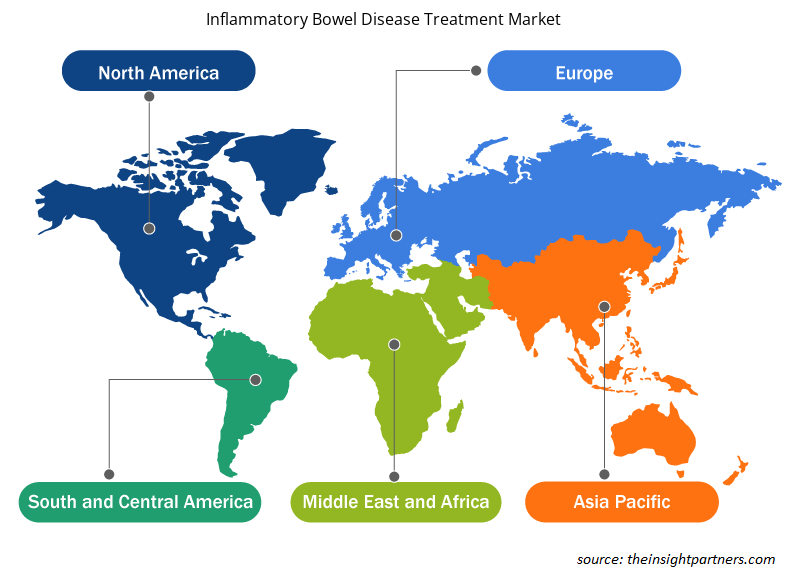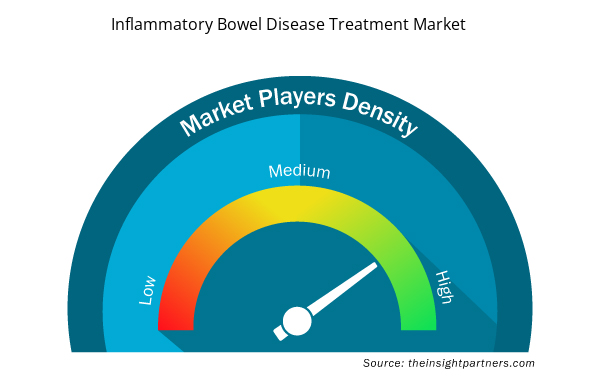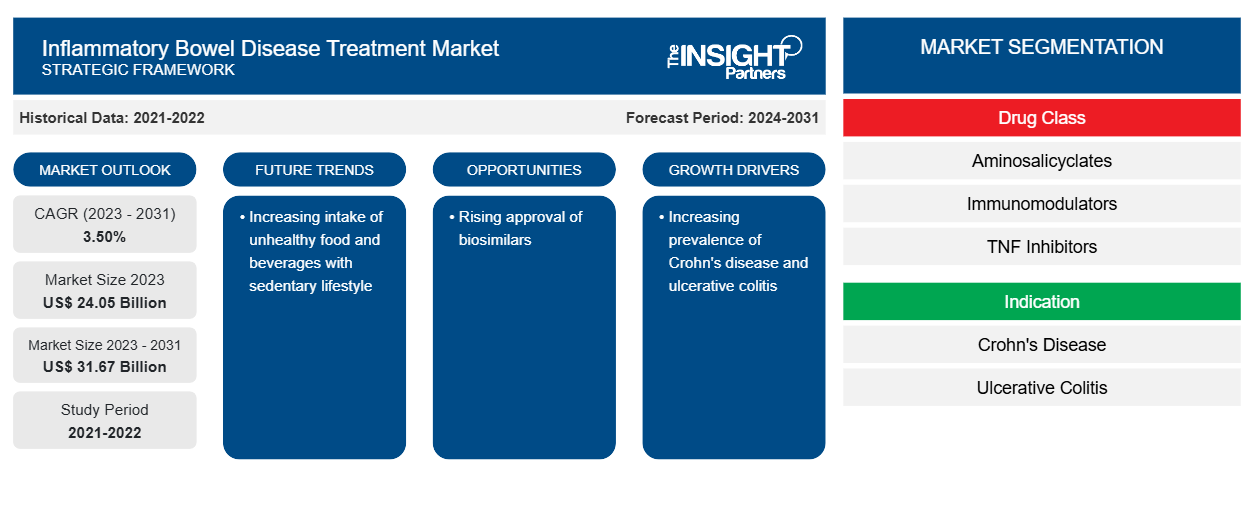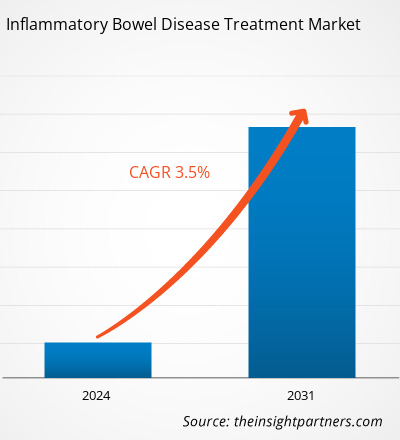من المتوقع أن تنمو القيمة السوقية لعلاج مرض التهاب الأمعاء من 24.05 مليار دولار أمريكي في عام 2023 إلى 31.67 مليار دولار أمريكي بحلول عام 2031؛ ومن المتوقع أن يسجل السوق معدل نمو سنوي مركب بنسبة 3.50٪ من عام 2023 إلى عام 2031.
رؤى السوق ووجهة نظر المحلل:
مرض التهاب الأمعاء (IBD) هو حالة التهابية مزمنة في الجهاز الهضمي، بما في ذلك مرض كرون والتهاب القولون التقرحي. تسبب هذه الحالات التهاب بطانة الجهاز الهضمي، مما يؤدي إلى أعراض مثل آلام البطن والإسهال والتعب وفقدان الوزن. يهدف العلاج إلى تقليل الالتهاب وإدارة الأعراض ومنع المضاعفات من خلال الأدوية وتغييرات نمط الحياة وأحيانًا الجراحة. تتطلب إدارة مرض التهاب الأمعاء عادةً رعاية طبية مستمرة ومراقبة للحفاظ على الهدوء وتحسين نوعية الحياة. العوامل الرئيسية التي تدفع نمو سوق علاج مرض التهاب الأمعاء هي الانتشار المتزايد لمرض كرون والتهاب القولون التقرحي، والعدد المتزايد من إطلاق المنتجات. يتضمن هذا التقرير آفاق النمو بسبب اتجاهات سوق علاج مرض التهاب الأمعاء الحالية وتأثيرها المتوقع خلال فترة التنبؤ. من المرجح أن تجلب التطورات التكنولوجية اتجاهات مهمة في سوق علاج مرض التهاب الأمعاء في السنوات القادمة. علاوة على ذلك، من المتوقع أيضًا أن يؤدي تطوير العلاجات المبتكرة من خلال البحث المستمر بالإضافة إلى تشجيع المبادرات الحكومية إلى تغذية نمو السوق.
محركات النمو والتحديات:
مرض كرون هو اضطراب مزمن معقد يؤثر في المقام الأول على الجهاز الهضمي. ذكرت المكتبة الوطنية للطب أنه كان هناك 825 حالة من مرض التهاب الأمعاء لكل 100000 شخص في عام 2023، بما في ذلك مقارنة بـ 410 حالات من مرض كرون و 414 حالة من التهاب القولون التقرحي ومرض التهاب الأمعاء. مع انتشار بنسبة 0.82٪، كان 322600 كندي مصابين بمرض التهاب الأمعاء في عام 2023. المرضى الذين يعانون من أمراض الجهاز الهضمي معرضون لخطر متزايد من التدهور الغذائي بسبب متطلبات الصيام للاختبارات التشخيصية والقيود الغذائية العلاجية وفقدان الشهية بسبب فقدان الشهية أو المتطلبات الغذائية المتغيرة الناجمة عن المرض نفسه. وبالتالي، يتم وصف التغذية المعوية لمرضى أمراض الجهاز الهضمي، حيث يفضل الطريق المعوي لتوفير العناصر الغذائية المطلوبة. لذلك، فإن الانتشار المتزايد لمرض كرون والتهاب القولون التقرحي يدفع نمو سوق علاج مرض التهاب الأمعاء.
مرض كرون، وأمراض الجهاز الهضمي بسبب الصدمات، وانسداد الأمعاء، والتهاب القولون المجهري، ومتلازمة الأمعاء القصيرة ، والتهاب القولون التقرحي هي بعض من أمراض الجهاز الهضمي الشائعة. وفقًا لمقال نُشر في Healthline في عام 2021، تأثر حوالي 40٪ من الأشخاص في جميع أنحاء العالم باضطرابات الجهاز الهضمي الوظيفية. ذكرت مؤسسة صحة الجهاز الهضمي الكندية أن ملايين الكنديين يعيشون بأمراض الجهاز الهضمي؛ يعاني حوالي 20 مليون كندي، أي 2 من كل 3 أشخاص، من اضطرابات الجهاز الهضمي سنويًا.
من ناحية أخرى، تشكل التكلفة المرتفعة المرتبطة بعلاج مرض التهاب الأمعاء (IBD) عائقًا كبيرًا في سوق علاج مرض التهاب الأمعاء. من الأدوية الباهظة الثمن إلى الاستشفاء المتكرر والعمليات الجراحية، يمكن لإدارة مرض التهاب الأمعاء أن تفرض عبئًا ماليًا ثقيلًا على المرضى وأنظمة الرعاية الصحية. غالبًا ما يحد عامل التكلفة من الوصول إلى الرعاية المثلى والعلاجات المبتكرة للعديد من الأفراد الذين يعيشون مع مرض التهاب الأمعاء. إن معالجة قضايا القدرة على تحمل التكاليف وإمكانية الوصول أمر بالغ الأهمية لتحسين النتائج ونوعية الحياة للمرضى المتأثرين بهذه الحالة المزمنة. وبالتالي، فإن التكلفة المرتفعة المرتبطة بالعلاج تعيق نمو سوق علاج مرض التهاب الأمعاء.
قم بتخصيص هذا التقرير ليناسب متطلباتك
ستحصل على تخصيص لأي تقرير - مجانًا - بما في ذلك أجزاء من هذا التقرير، أو تحليل على مستوى الدولة، وحزمة بيانات Excel، بالإضافة إلى الاستفادة من العروض والخصومات الرائعة للشركات الناشئة والجامعات
- احصل على أهم اتجاهات السوق الرئيسية لهذا التقرير.ستتضمن هذه العينة المجانية تحليلاً للبيانات، بدءًا من اتجاهات السوق وحتى التقديرات والتوقعات.
تقسيم التقرير ونطاقه:
تم إجراء تحليل سوق علاج مرض التهاب الأمعاء من خلال النظر في القطاعات التالية: فئة الدواء، ومؤشر المرض، وقناة التوزيع. بناءً على الجغرافيا، يتم تقسيم سوق علاج مرض التهاب الأمعاء إلى أمريكا الشمالية (الولايات المتحدة وكندا والمكسيك)، وأوروبا (المملكة المتحدة وألمانيا وفرنسا وإيطاليا وإسبانيا وبقية أوروبا)، وآسيا والمحيط الهادئ (الصين واليابان والهند وأستراليا وكوريا الجنوبية وبقية آسيا والمحيط الهادئ)، والشرق الأوسط وأفريقيا (الإمارات العربية المتحدة والمملكة العربية السعودية وجنوب أفريقيا وبقية الشرق الأوسط وأفريقيا)، وأمريكا الجنوبية والوسطى (البرازيل والأرجنتين وبقية أمريكا الجنوبية والوسطى).
التحليل القطاعي:
رؤى مبنية على فئات الأدوية
بناءً على فئة الدواء، يتم تقسيم السوق إلى العقاقير البيولوجية والأمينوساليسيلات والكورتيكوستيرويدات وغيرها. احتل قطاع العقاقير البيولوجية أكبر حصة في سوق علاج مرض التهاب الأمعاء في عام 2023، ومن المتوقع أن يسجل أعلى معدل نمو سنوي مركب خلال الفترة 2023-2031.
رؤى مبنية على مؤشرات المرض
بناءً على مؤشر المرض، ينقسم سوق علاج مرض التهاب الأمعاء إلى مرض كرون والتهاب القولون التقرحي. ومن المتوقع أن يحظى قطاع مرض كرون بحصة سوقية كبيرة بحلول عام 2031.
رؤى مبنية على مؤشرات المرض
بناءً على قناة التوزيع، يتم تصنيف السوق إلى صيدليات المستشفيات وصيدليات التجزئة والصيدليات عبر الإنترنت. ومن المتوقع أن يحظى قطاع صيدليات المستشفيات بحصة كبيرة في سوق علاج مرض التهاب الأمعاء بحلول عام 2031.
رؤى إقليمية حول سوق علاج مرض التهاب الأمعاء
لقد قام المحللون في Insight Partners بشرح الاتجاهات والعوامل الإقليمية المؤثرة على سوق علاج مرض التهاب الأمعاء طوال فترة التوقعات بشكل شامل. يناقش هذا القسم أيضًا قطاعات سوق علاج مرض التهاب الأمعاء والجغرافيا في جميع أنحاء أمريكا الشمالية وأوروبا ومنطقة آسيا والمحيط الهادئ والشرق الأوسط وأفريقيا وأمريكا الجنوبية والوسطى.

- احصل على البيانات الإقليمية المحددة لسوق علاج مرض التهاب الأمعاء
نطاق تقرير سوق علاج مرض التهاب الأمعاء
| سمة التقرير | تفاصيل |
|---|---|
| حجم السوق في عام 2023 | 24.05 مليار دولار أمريكي |
| حجم السوق بحلول عام 2031 | 31.67 مليار دولار أمريكي |
| معدل النمو السنوي المركب العالمي (2023 - 2031) | 3.50% |
| البيانات التاريخية | 2021-2022 |
| فترة التنبؤ | 2024-2031 |
| القطاعات المغطاة | حسب فئة الدواء
|
| المناطق والدول المغطاة | أمريكا الشمالية
|
| قادة السوق وملفات تعريف الشركات الرئيسية |
|
كثافة اللاعبين في سوق علاج مرض التهاب الأمعاء: فهم تأثيرها على ديناميكيات الأعمال
يشهد سوق علاج مرض التهاب الأمعاء نموًا سريعًا، مدفوعًا بالطلب المتزايد من المستخدم النهائي بسبب عوامل مثل تفضيلات المستهلكين المتطورة والتقدم التكنولوجي والوعي المتزايد بفوائد المنتج. ومع ارتفاع الطلب، تعمل الشركات على توسيع عروضها والابتكار لتلبية احتياجات المستهلكين والاستفادة من الاتجاهات الناشئة، مما يؤدي إلى زيادة نمو السوق.
تشير كثافة اللاعبين في السوق إلى توزيع الشركات أو المؤسسات العاملة في سوق أو صناعة معينة. وهي تشير إلى عدد المنافسين (اللاعبين في السوق) الموجودين في مساحة سوق معينة نسبة إلى حجمها أو قيمتها السوقية الإجمالية.
الشركات الرئيسية العاملة في سوق علاج مرض التهاب الأمعاء هي:
- شركة فايزر،
- شركة نوفارتيس ايه جي،
- شركة آبفي،
- شركة تاكيدا للأدوية، جونسون آند جونسون
- ، شركة سيليجين،
- شركات بوش الصحية
إخلاء المسؤولية : الشركات المذكورة أعلاه ليست مرتبة بأي ترتيب معين.

- احصل على نظرة عامة على أهم اللاعبين الرئيسيين في سوق علاج مرض التهاب الأمعاء
التحليل الإقليمي:
يغطي النطاق الجغرافي لتقرير سوق علاج مرض التهاب الأمعاء أمريكا الشمالية وأوروبا ومنطقة آسيا والمحيط الهادئ والشرق الأوسط وأفريقيا وأمريكا الجنوبية والوسطى. في عام 2023، احتلت أمريكا الشمالية أكبر حصة سوقية. تهيمن الولايات المتحدة على السوق في أمريكا الشمالية بأكبر حصة من الإيرادات. يُعزى توسع حجم سوق علاج مرض التهاب الأمعاء في هذا البلد إلى زيادة انتشار الأمراض الالتهابية ووجود كبار اللاعبين في السوق ومبادراتهم الاستراتيجية. كما تفيد حلول الدفع المحسنة ومعدلات العلاج المرتفعة والوصفات الطبية المتزايدة للأدوية المبتكرة وجهود البحث المتواصلة والمبادرات الحكومية المواتية سوق علاج مرض التهاب الأمعاء في الولايات المتحدة ودول أمريكا الشمالية الأخرى. مؤسسة كرون والتهاب القولون هي واحدة من المنظمات البارزة المخصصة لتعزيز البحث السريري والترجمي بهدف علاج التهاب القولون ومرض كرون.
المنافسة والشركات الرئيسية:
يمكن أن تساعد توقعات سوق علاج مرض التهاب الأمعاء المقدمة في هذا التقرير أصحاب المصلحة في هذا السوق في التخطيط لاستراتيجيات النمو الخاصة بهم. تعد AbbVie Inc وTakeda Pharmaceutical Company Limited وPfizer Inc وBiogen وNovartis AG وLilly وUCB SA وCELLTRION INC. وMerck & Co.، Inc. وJohnson & Johnson Services، Inc. من بين الشركات الرئيسية التي تم عرضها في تقرير سوق علاج مرض التهاب الأمعاء. تركز هذه الشركات على توسيع عروضها لتلبية الطلب المتزايد من المستهلكين في جميع أنحاء العالم. يسمح لها وجودها العالمي بخدمة العديد من العملاء، مما يسمح لها لاحقًا بتوسيع وجودها في السوق.
- التحليل التاريخي (سنتان)، السنة الأساسية، التوقعات (7 سنوات) مع معدل النمو السنوي المركب
- تحليل PEST و SWOT
- حجم السوق والقيمة / الحجم - عالميًا وإقليميًا وقطريًا
- الصناعة والمنافسة
- مجموعة بيانات Excel


- Digital Language Learning Market
- Smart Grid Sensors Market
- Customer Care BPO Market
- Battery Testing Equipment Market
- Airline Ancillary Services Market
- Collagen Peptides Market
- Arterial Blood Gas Kits Market
- Semiconductor Metrology and Inspection Market
- MEMS Foundry Market
- Long Read Sequencing Market

Report Coverage
Revenue forecast, Company Analysis, Industry landscape, Growth factors, and Trends

Segment Covered
This text is related
to segments covered.

Regional Scope
North America, Europe, Asia Pacific, Middle East & Africa, South & Central America

Country Scope
This text is related
to country scope.
الأسئلة الشائعة
Based on drug class, the market is segmented into biologics, aminosalicyclates, corticosteroids, and others. The biologics segment held the largest Inflammatory Bowel Disease Treatment Market share in 2023 and is anticipated to register the highest CAGR during 2023–2031.
Based on disease indication, the Inflammatory Bowel Disease Treatment Market is segmented into crohn's disease and ulcerative colitis. The crohn's disease segment is anticipated to hold a significant share by 2031.
The Inflammatory Bowel Disease Treatment Market was valued at US$ 24.05 billion in 2023.
The Inflammatory Bowel Disease Treatment Market is expected to be valued at US$ 31.67 billion in 2031.
The Inflammatory Bowel Disease Treatment Market has major market players, including AbbVie Inc, Takeda Pharmaceutical Company Limited, Pfizer Inc, Biogen, Novartis AG, Lilly, UCB S.A., CELLTRION INC., Merck & Co., Inc., and Johnson & Johnson Services, Inc.
The key factors driving the Inflammatory Bowel Disease Treatment Market growth are the rising prevalence of crohn's disease and ulcerative colitis and increasing product launches over the projection period. Inflammatory Bowel Disease Treatment Market trends include the technological advancement in IBD treatment. Furthermore, the development of innovative treatments through continuing research as well as encouraging government initiatives are also expected to fuel the market growth.
Inflammatory bowel disease" (IBD) is a chronic inflammatory condition of the gastrointestinal tract, including Crohn's disease and ulcerative colitis. These conditions cause inflammation of the digestive tract lining, leading to symptoms like abdominal pain, diarrhea, fatigue, and weight loss. Treatment aims to reduce inflammation, manage symptoms, and prevent complications through medication, lifestyle changes, and sometimes surgery. Managing IBD typically requires ongoing medical care and monitoring to maintain remission and improve quality of life.
Trends and growth analysis reports related to Life Sciences : READ MORE..
The List of Companies - Inflammatory Bowel Disease Treatment Market
- AbbVie Inc
- Takeda Pharmaceutical Company Limited
- Pfizer Inc
- Biogen
- Novartis AG
- Lilly
- UCB S.A.
- CELLTRION INC.
- Merck & Co., Inc.
- Johnson & Johnson Services, Inc.
- Mindray Medical International Limited
The Insight Partners performs research in 4 major stages: Data Collection & Secondary Research, Primary Research, Data Analysis and Data Triangulation & Final Review.
- Data Collection and Secondary Research:
As a market research and consulting firm operating from a decade, we have published and advised several client across the globe. First step for any study will start with an assessment of currently available data and insights from existing reports. Further, historical and current market information is collected from Investor Presentations, Annual Reports, SEC Filings, etc., and other information related to company’s performance and market positioning are gathered from Paid Databases (Factiva, Hoovers, and Reuters) and various other publications available in public domain.
Several associations trade associates, technical forums, institutes, societies and organization are accessed to gain technical as well as market related insights through their publications such as research papers, blogs and press releases related to the studies are referred to get cues about the market. Further, white papers, journals, magazines, and other news articles published in last 3 years are scrutinized and analyzed to understand the current market trends.
- Primary Research:
The primarily interview analysis comprise of data obtained from industry participants interview and answers to survey questions gathered by in-house primary team.
For primary research, interviews are conducted with industry experts/CEOs/Marketing Managers/VPs/Subject Matter Experts from both demand and supply side to get a 360-degree view of the market. The primary team conducts several interviews based on the complexity of the markets to understand the various market trends and dynamics which makes research more credible and precise.
A typical research interview fulfils the following functions:
- Provides first-hand information on the market size, market trends, growth trends, competitive landscape, and outlook
- Validates and strengthens in-house secondary research findings
- Develops the analysis team’s expertise and market understanding
Primary research involves email interactions and telephone interviews for each market, category, segment, and sub-segment across geographies. The participants who typically take part in such a process include, but are not limited to:
- Industry participants: VPs, business development managers, market intelligence managers and national sales managers
- Outside experts: Valuation experts, research analysts and key opinion leaders specializing in the electronics and semiconductor industry.
Below is the breakup of our primary respondents by company, designation, and region:

Once we receive the confirmation from primary research sources or primary respondents, we finalize the base year market estimation and forecast the data as per the macroeconomic and microeconomic factors assessed during data collection.
- Data Analysis:
Once data is validated through both secondary as well as primary respondents, we finalize the market estimations by hypothesis formulation and factor analysis at regional and country level.
- Macro-Economic Factor Analysis:
We analyse macroeconomic indicators such the gross domestic product (GDP), increase in the demand for goods and services across industries, technological advancement, regional economic growth, governmental policies, the influence of COVID-19, PEST analysis, and other aspects. This analysis aids in setting benchmarks for various nations/regions and approximating market splits. Additionally, the general trend of the aforementioned components aid in determining the market's development possibilities.
- Country Level Data:
Various factors that are especially aligned to the country are taken into account to determine the market size for a certain area and country, including the presence of vendors, such as headquarters and offices, the country's GDP, demand patterns, and industry growth. To comprehend the market dynamics for the nation, a number of growth variables, inhibitors, application areas, and current market trends are researched. The aforementioned elements aid in determining the country's overall market's growth potential.
- Company Profile:
The “Table of Contents” is formulated by listing and analyzing more than 25 - 30 companies operating in the market ecosystem across geographies. However, we profile only 10 companies as a standard practice in our syndicate reports. These 10 companies comprise leading, emerging, and regional players. Nonetheless, our analysis is not restricted to the 10 listed companies, we also analyze other companies present in the market to develop a holistic view and understand the prevailing trends. The “Company Profiles” section in the report covers key facts, business description, products & services, financial information, SWOT analysis, and key developments. The financial information presented is extracted from the annual reports and official documents of the publicly listed companies. Upon collecting the information for the sections of respective companies, we verify them via various primary sources and then compile the data in respective company profiles. The company level information helps us in deriving the base number as well as in forecasting the market size.
- Developing Base Number:
Aggregation of sales statistics (2020-2022) and macro-economic factor, and other secondary and primary research insights are utilized to arrive at base number and related market shares for 2022. The data gaps are identified in this step and relevant market data is analyzed, collected from paid primary interviews or databases. On finalizing the base year market size, forecasts are developed on the basis of macro-economic, industry and market growth factors and company level analysis.
- Data Triangulation and Final Review:
The market findings and base year market size calculations are validated from supply as well as demand side. Demand side validations are based on macro-economic factor analysis and benchmarks for respective regions and countries. In case of supply side validations, revenues of major companies are estimated (in case not available) based on industry benchmark, approximate number of employees, product portfolio, and primary interviews revenues are gathered. Further revenue from target product/service segment is assessed to avoid overshooting of market statistics. In case of heavy deviations between supply and demand side values, all thes steps are repeated to achieve synchronization.
We follow an iterative model, wherein we share our research findings with Subject Matter Experts (SME’s) and Key Opinion Leaders (KOLs) until consensus view of the market is not formulated – this model negates any drastic deviation in the opinions of experts. Only validated and universally acceptable research findings are quoted in our reports.
We have important check points that we use to validate our research findings – which we call – data triangulation, where we validate the information, we generate from secondary sources with primary interviews and then we re-validate with our internal data bases and Subject matter experts. This comprehensive model enables us to deliver high quality, reliable data in shortest possible time.


 احصل على عينة مجانية لهذا التقرير
احصل على عينة مجانية لهذا التقرير